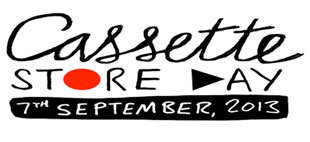![]() Where vinyl and cassette once conspired to carry music in a beautiful symmetry of quality and portability, they have been brought head-to-head by the launch of Cassette Store Day. Rather than reuniting the old team, this has divided opinion over their relative worth.
Where vinyl and cassette once conspired to carry music in a beautiful symmetry of quality and portability, they have been brought head-to-head by the launch of Cassette Store Day. Rather than reuniting the old team, this has divided opinion over their relative worth.
We’ve become used to the succession of ‘format wars’, but this has to be the first engagement fought between obsolete and obsolescent media…
The first Record Store Day (RSD) took place in 2007, when more than 700 independent music stores in the US celebrated their place in today’s music market though assorted events, artists’ appearances and special album releases – some on vinyl. It has since become an international event, and offers a rallying point for music makers and music lovers in support of independent music sellers.
Just one week ago, Cassette Store Day (CSD) followed suit, offering its own round of international events and music releases from the likes of Deerhunter, Animal Collective and Flaming Lips – 50 years after Philips unveiled it at the Berlin Radio Show. Where Record Store Day set out to ‘recognise the unique culture surrounding over 700 independently owned record stores in the US and thousands of similar stores internationally’, Cassette Store Day aims to ‘highlight the format’s resurgence, as well as providing an outlet for new music’.

‘This is more about celebrating the continued existence and usefulness of a predominantly overlooked, yet still current, format, rather than fetishising something obsolete,’ says Cassette Store Day co-founder, Steve Rose.
But to many others, the old cassette remains vinyl’s poor relation; intractably associated with failing audio quality, tape jams and motorway streamers. Cassettes certainly can’t contest vinyl’s appeal to audiophile quality, or the art it wears on its sleeves. And its claim to portability is greatly overshadowed by the convenience and reliability of MP3 and other digital delivery systems.
Excepting a relatively small number of collectors’ rarities, cassettes have not held their value in the same way some vinyl has. On top of that, figures for 2013 have cassette sales at 0.02% of overall album sales (Nielsen SoundScan), while vinyl LP holds a 2% share of the album market.
Somehow the cassette – for all its technical achievement and cultural significance – has failed to win the same affection as its vinyl playmate. But there’s another side to the old cassette…
Skill in music
To the music consumer, the Compact Cassette brought ‘mixtapes’ and the first Walkman. And while it brought piracy paranoia to the music industry, it brought the home studio to the music maker.
 The major music labels sought a levy on all blank tape sales to offset the royalties they believed they were losing through illegal copying. Their ‘Home taping is Killing Music’ campaign invited protests from various quarters, including the ‘Home Taping is Skill in Music’ counteroffensive launched by users of a new breed of cassette recorder.
The major music labels sought a levy on all blank tape sales to offset the royalties they believed they were losing through illegal copying. Their ‘Home taping is Killing Music’ campaign invited protests from various quarters, including the ‘Home Taping is Skill in Music’ counteroffensive launched by users of a new breed of cassette recorder.
Teac brought a genuine revolution to music recording with the release of 144 Portastudio in 1979 (also the year in which the Walkman appeared). Based on the same mechanical format as the domestic cassette, this bumped the tape speed from 1⅞ ips to 3.75 ips, and used all four tracks in a studio multitrack arrangement, complete with sync overdubbing. Inevitably, other four-track ‘personal multitracks’ followed, and Sansui pushed a little harder with its MR-6 and WSX-1 six-track based machines. But it was the cassette that made it all possible.
Along with the arrival of Midi in 1982 (also the year that the CD arrived), the cassette multitrack had signalled a tectonic change in the commercial recording studio market, ahead of digital audio and hard-disc recording. It might have served Steve Rose (and Cassette Store Day co-founders Matt Flag and Jen Long) well to have picked up on this.
While the Compact Cassette is assured a place in modern cultural history and the development of music recording, it seems unlikely to fulfil the ambitions of the CSD crew. Contrarily, very few young music fans or music makers have ever seen, let alone used a cassette. And yet they are keeping it alive as an icon, through tee-shirts, graffiti and even the iPhone case.
‘The cassette has transformed over the years from a functional music medium into a visual pop art object,' agrees Brighton graffiti artist, Cassette Lord. ‘The home recorded cassette mix tape was a revolution in editing and personalising of music, and became a deeply intimate object passed between millions of friends with handwritten inlays, stickers and painted covers. This capacity for personalisation and re-recordable function helped embed the cassette tape into people’s hearts allowing it to transcend its simple functionality. Some think it has a face...’

